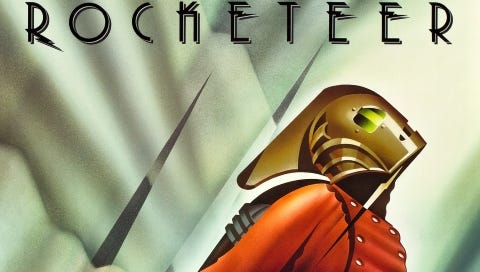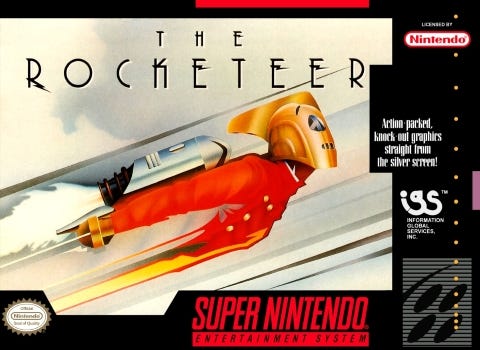When Dave Stevens introduced the world (or, at least, the considerably smaller indie comics world) to The Rocketeer in 1982, nobody in Hollywood wanted to make a movie based on a comic book, much less Disney. Seven years later, Tim Burton’s Batman changed all that. All of a sudden, everyone was digging through back issue boxes and old newspapers trying to find the next big superhero. Unfortunately, Disney’s 1991 movie version of The Rocketeer did not become that Batman-level phenomenon. But artistically and creatively, it holds up as one of the very best comic book movies ever made.
Stevens’ comic book detailed the exploits of stunt pilot Cliff Secord as he finds a jet pack prototype that enables him to become the high-flying Rocketeer. The comic was inspired by the serials of the 1930s and 40s and featured characters modeled on pulp heroes and such real-life cult figures as pinup model Bettie Page and character actor Rondo Hatton. Stevens knew early on that he wanted to see the character make the leap to the big screen. But in the early 1980s, nobody was looking to comics for source material, much less independent comics like The Rocketeer. The few who did show interest wanted to jettison the pre-World War II period setting and update the story to modern times, which was a non-starter for Stevens.
In 1985, Stevens met Danny Bilson and Paul De Meo, a screenwriting team whose first script, Trancers, had just been produced by Charles Band’s Empire Pictures. Bilson and De Meo were big fans of the comic and understood the vibe Stevens was going for. For a while, they considered making the film independently, fully embracing the retro aesthetic as a black-and-white homage to 1930s serials. That idea was dropped after they teamed up with William Dear, a Canadian director who had partnered with ex-Monkee Michael Nesmith on the pioneering proto-music video Elephant Parts and the low-budget sci-fi adventure Timerider. Dear worked with Bilson and De Meo to expand the scope of the script and became attached to direct.
With Dear on board, the group began pitching the project around Hollywood. The studios could not have been less interested. Finally, they arrived at Disney, now operating under the new regime of Michael Eisner and Jeffrey Katzenberg. They weren’t completely sold on the idea either but picked it up anyway, intending to funnel it into the Touchstone division. But before long, Katzenberg recognized the character’s potential for toys and other ancillary merchandise and switched it over to the Disney track.
Development at Disney took years with Bilson and De Meo getting fired and rehired on multiple occasions. The studio would demand changes to the script. When those didn’t work out, they demanded it be changed back to the way it was in the first place. A few of those changes stuck. Cliff’s girlfriend, Betty, became Jenny and had her profession changed from girlie magazine model to background extra, partly to keep the movie safely in PG territory but also to avoid a lawsuit by the real Bettie Page, who was very much still alive at the time. As the years wore on, Stevens, Bilson and De Meo grew increasingly frustrated with the studio’s notes, while Dear ended up leaving the project completely (we’ll see him back in this column eventually).
While Disney continued to tinker with The Rocketeer and figure out whether or not they even wanted to make the movie, Joe Johnston came aboard to direct Honey, I Shrunk The Kids. When he found out that Disney was developing a Rocketeer project, he threw his name in the hat to direct. Johnston was also a fan of Stevens’ comic and was excited to take it on. Happy with his work replacing Stuart Gordon on Honey, I Shrunk The Kids (and more than happy with that film’s $100+ million take at the box office), Disney gave him the green light.
Unfortunately, Johnston’s hiring did not spell the end of Disney’s concerns. The studio wanted a name actor to play Cliff Secord. Their wish list included such names as Kevin Costner, Disney alumnus Kurt Russell, Stakeout star Emilio Estevez and Johnny Depp (needless to say, he got his shot at Disney stardom later). Johnston and Stevens lobbied for Billy Campbell. Campbell, who had gone from William to Bill before eventually settling on Billy in the late ‘90s, was essentially an unknown. He’d had a recurring role on the fifth season of the prime-time soap Dynasty and was a regular on the critically acclaimed but low-rated drama Crime Story but his film credits were practically non-existent. Disney needed a lot of convincing but when it became clear that none of the A-listers they wanted were going to say yes, they nervously allowed Johnston to cast Campbell.
For a time, saying no to The Rocketeer appeared to be a favorite pastime among Hollywood’s A-list. Lloyd Bridges turned down the role of A. “Peevy” Peabody, Cliff’s longtime mechanic and father figure, so the part went to Alan Arkin. Jeremy Irons passed on playing villainous movie star Neville Sinclair, opening the door for former James Bond Timothy Dalton. And Joe Pesci said no to playing gangster Eddie Valentine, a role that had been written with him in mind. Instead, the part went to Paul Sorvino.
Johnston also considered a number of actresses for the role of Jenny, including Diane Lane, Sherilyn Fenn and Adventures In Babysitting costar Penelope Ann Miller, before finally settling on Jennifer Connelly. A former model, Connelly had appeared in such films as Jim Henson’s Labyrinth but was still honing her craft as an actress. However, her skill noticeably improved with each screen appearance. She’d continue to get better and better after The Rocketeer, ultimately winning an Oscar for her work in A Beautiful Mind.
Disney originally budgeted the picture at $25 million. But once they got a look at Johnston’s footage, they gave the production a vote of confidence and upped it to $35 million. The extra money went to good use, creating a spectacular finale set aboard a zeppelin in the skies above Los Angeles. The studio might not have known exactly what to make of The Rocketeer but their commitment to helping Johnston achieve his vision was admirable.
Joe Johnston worked closely with Dave Stevens to ensure that the movie was as faithful to the comics as possible. Make no mistake, this is a sanitized version of The Rocketeer, cleaned up to attract a family audience. But Johnston captures the charm and innocence of the book with several shots directly adapted from Stevens’ meticulous artwork. It’s also a refreshingly self-contained adventure. While the door is left open for potential sequels, this story is wrapped up without any dangling loose ends.
Disney had high hopes for The Rocketeer when it arrived in theatres on June 21, 1991. The studio spent an additional fortune on advertising and Katzenberg’s dreams of Rocketeer toys, video games and tie-ins came true. Unfortunately, none of that seemed to help. The movie opened in a distant fourth place behind blockbuster holdovers Robin Hood, Prince Of Thieves and City Slickers. The fact that it couldn’t even outgross the Julia Roberts tearjerker Dying Young probably set off a few alarm bells at Disney. Critics generally liked it, although it proved to be a little too old-fashioned for some. In the end, The Rocketeer only made around $46 million, a far cry from Batman’s haul, scuttling any plans for a sequel.
Following the release of the film, Dave Stevens produced one more issue of The Rocketeer Adventure Magazine that was finally published in 1995. But he’d finally had enough of struggling with multiple indie publishers and decided to retire the character. He’d never been a particularly fast artist and his output slowed even more after he was diagnosed with a rare form of leukemia. Dave Stevens died in 2008 at the age of 52.
Even though it wasn’t a huge hit, The Rocketeer has had an enduring legacy. In 2008, Kevin Feige, head of the not-yet-Disney-owned Marvel Studios, hired Joe Johnston to direct Captain America: The First Avenger. Johnston’s work on The Rocketeer was a major factor in landing that gig. In 2019, an animated spinoff aimed at preschoolers debuted on Disney Junior. It doesn’t bear much resemblance to the movie and even less to Stevens’ work but I am perhaps not the best judge of entertainment for the age-6-and-below demographic. And of course, because Disney’s gonna Disney, a potential reboot or sequel is bandied about every so often.
For now, however, The Rocketeer remains relatively untouched, an underrated gem in Disney’s back catalog. It’s a highly entertaining adventure and a welcome throwback to a time before superhero movies began crumbling underneath the weight of their own world-building. If the studio does pursue a sequel or reboot, I hope the new filmmakers take a page out of Johnston’s book and keep things pure and simple.
VERDICT: Disney Plus









The documentary on Dave Stevens is a wonderful tribute to the artist.
The score is probably one of my top ten.